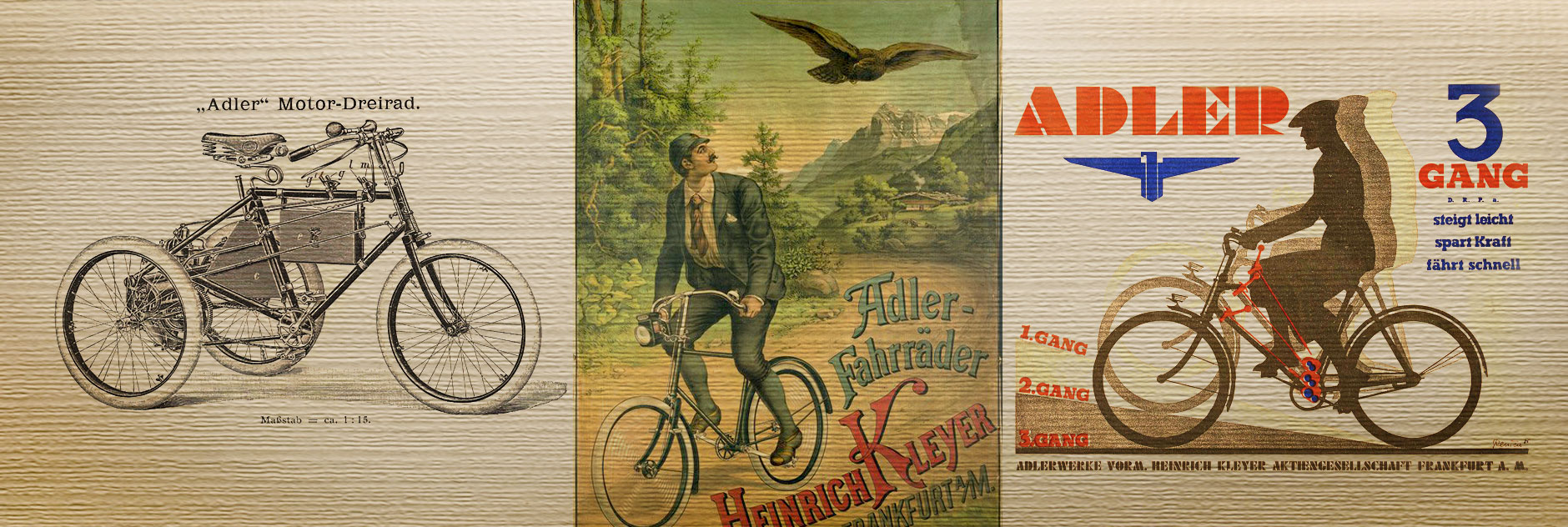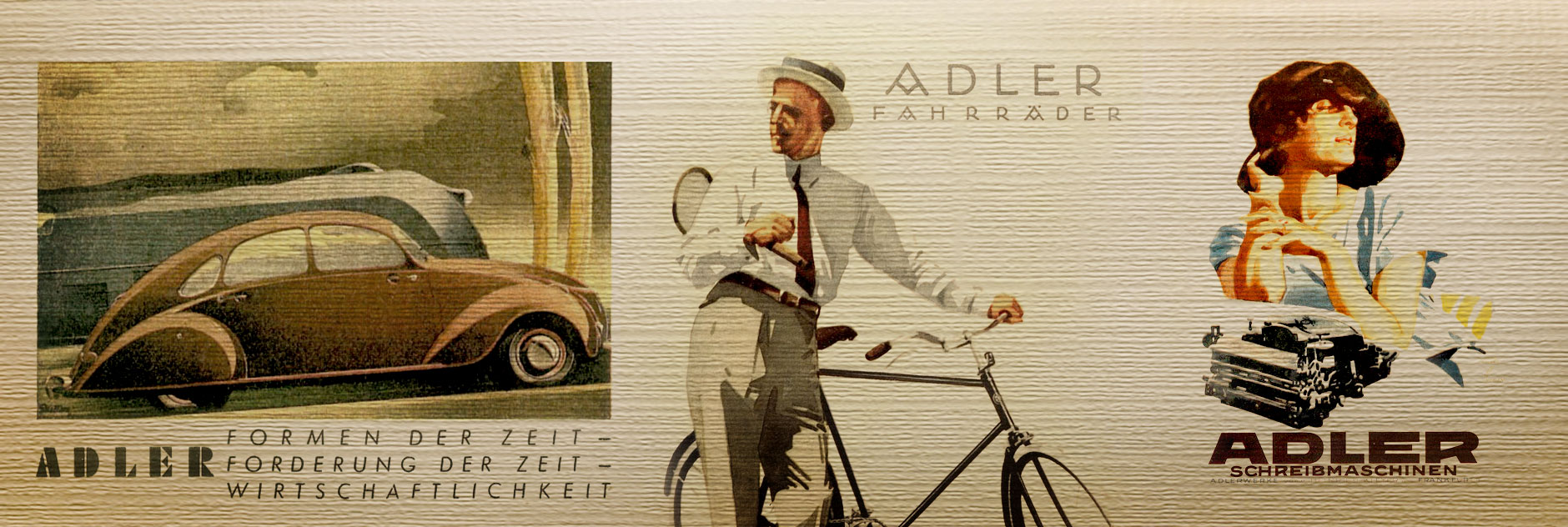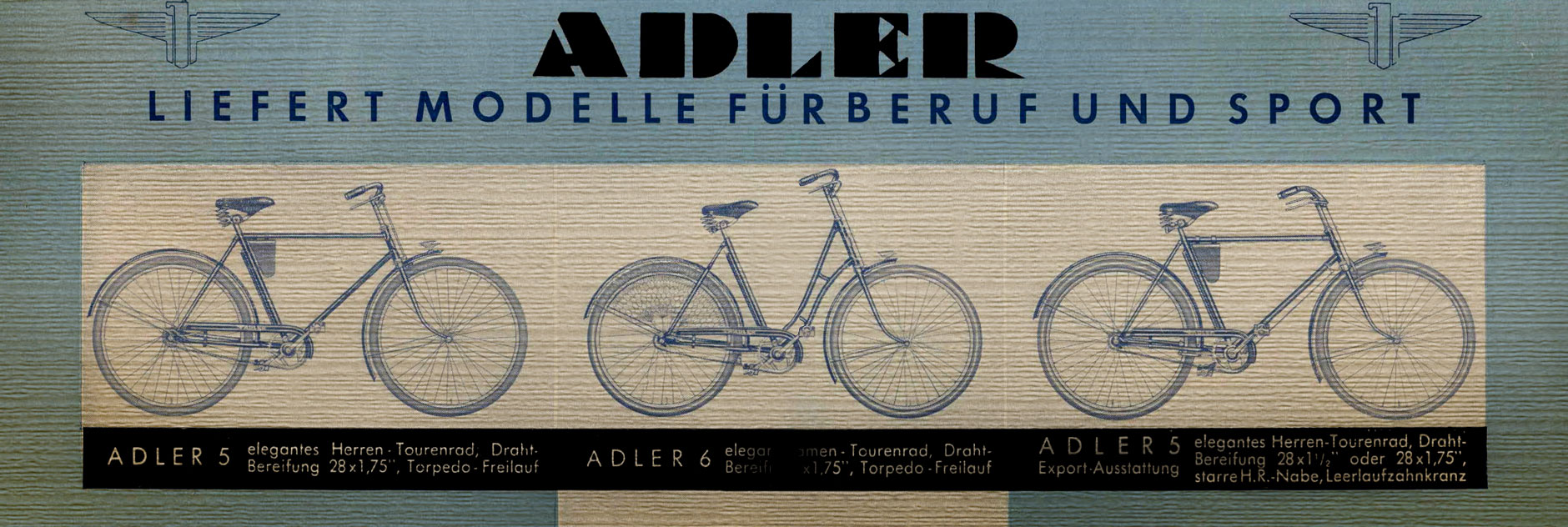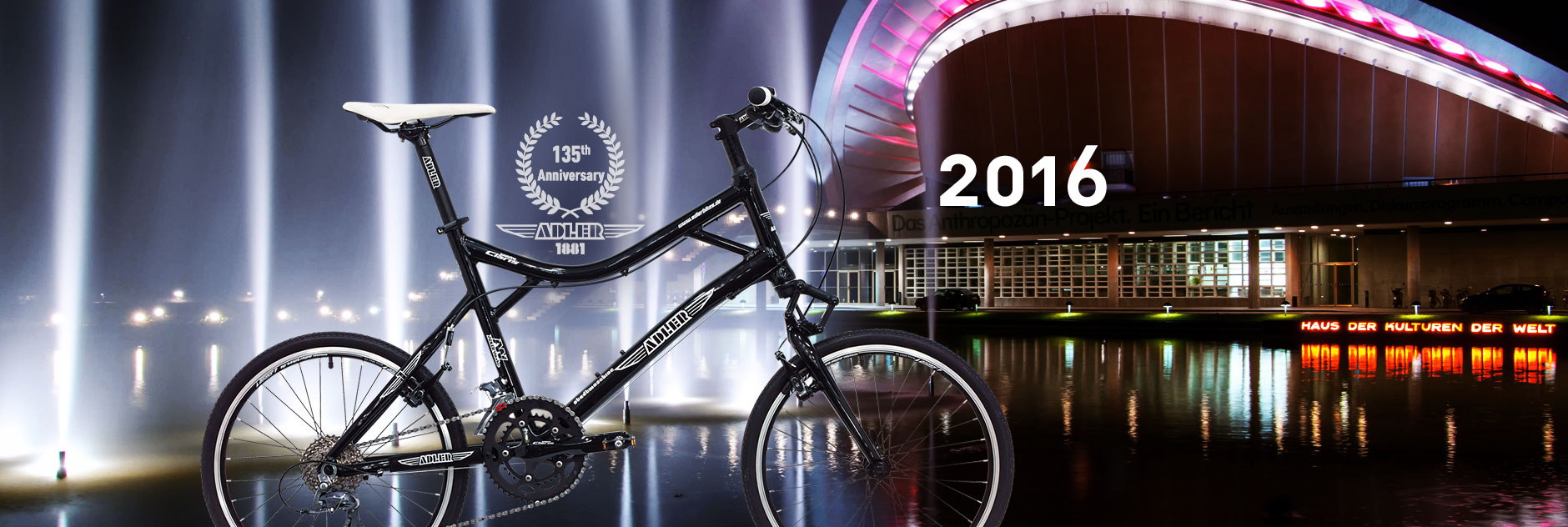
1880 - 1914
1880 - Pioneer Heinrich Kleyer
Heinrich Kleyer (1853-1932), entrepreneur and pioneer, founds a small machine business in Frankfurt am Main and sells bicycles imported from England.
One year later, Kleyer begins the industrial manufacture of bicycles, becoming the first in Germany to do so. KleyerÕs numerous new developments and the firm's own velodrome help to make cycling a popular pastime.
1886 - First Adler low-gear bicycle
The rapidly growing company becomes the corporation Adler-Fahrradwerke vorm. Heinrich Kleyer. In 1886 the Darmstadt-born entrepreneur introduces the innovation of the pneumatic tyre to Germany and brings the first Adler low-gear bicycle onto the market. In 1887 Kleyer becomes Purveyor to the Imperial War Ministry and receives numerous state contracts for bicycles and tricycles.
1889 - New factory built on Hoechster Strasse
Construction is commenced on the first new factory.
The factory is located on Hoechste Strasse (today known as Kleyerstrasse), where the entrepreneur had purchased a large site covering 18,000 m2 two years previously. On this site, located alongside Frankfurt Hauptbahnhof, the massive complex of the Adler factories will take shape over the next few years.
1898 - "Empire" typewriter
Bicycles are not the only things to be produced on Hoechster Strasse.
Kleyer demonstrates his keen intuition for future-orientated technologies by beginning factory production of typewriters, once again as the first entrepreneur in Germany to do so. The first results are released onto the market under the name of Empire. A record number of people are working as stenotypists and typewriters take offices by storm.
1899 - Adler Motorcar No. 1
Kleyer takes the plunge into the automotive industry.
At the 1900 Automobile Fair in Frankfurt, he presents the first Adler motorcar. A few short years later, there are 20 different Adler models to choose from. The company now changes its name to "Adlerwerke vorm. Heinrich Kleyer AG".
1900 - Legendary Model 7
The legendary Adler Model 7 typewriter comes onto the market.
It is to establish the international reputation of Adler office machines. As an elegant finishing touch this technically brilliant office machine bears the company décor on its protective cover. In 1910, production of office machines begins. In 1913, the first portable Adler typewriters come onto the market.
1914 - 7,000 employees
Before the outbreak of the First World War, the Adler factories employ around 7,000 people.
Since the company's formation, well over 100,000 Adler typewriters have left the factory. 55,000 cars drive on Germany's roads, one in five of which is an Adler. During the war, production has to be shifted to lorries, ambulances and special engines.

1915 - 1930
1925 - Model 25 typewriter sets new standards
After the disruption caused by the war and the revolution, typewriter production is back in full swing by 1920. The Model 25 comes onto the market. It impresses with its very high stability and line accuracy. Among the most significant technical innovations it brings is its shorter keystroke length. In office accessories, there is also an "Endless Form" device.
1926 The Adler Standard 6 car sensation
At the Berlin Automobile Fair in Autumn 1926, the Standard 6 is unveiled - a milestone in the history of Adler.
It is the first German production car and is distinguished by its solid steel bodywork and hydraulic four-wheel braking. The Standard 6 in all its variants and its little brother, the Adler Favorit, enjoy immense popularity.
1927 - Big step with the Little Adler
A big step forward occurs in the form of the Little Adler Model 2.
The low weight of this portable office machine, its manageability and its light touch rapidly make the Little Adler a commercial success. The chic Little Adler becomes the preferred tool of the trade for authors, reporters, businessmen and men of independent means.
1929 - First circumnavigation of the globe in an Adler car
Clairenore Stinnes’ spectacular coup for Adler and for German industry.
The journalist and racing driver is the first to circumnavigate the globe in a car. Through deserts and mountainous regions, under extreme climatic conditions, the daughter of industry baron Hugo Stinnes drives around the world in a Standard 6 - at a time when very few countries even had roads suitable for motor vehicles.
1930 - Bauhaus director Walter Gropius designs for Adler
The New York Stock Exchange crashes, there is a world economic crisis, and dramatic falls in sales are seen in the car sector as well.
Profession Walter Gropius, a world-famous architect and director of Bauhaus Dessau, designs bodyworks for large Adler cars. Gropius also designs the Adler emblem, with its widely spread wings. From 1930 onwards, it adorns the radiator grille of Adler cars.

1931 - 1945
1931 - Accounting machine with calculator
The new flat-typing Adler accounting machine – presented for the first time at the International Office Machine Fair in Berlin – is a major new development.
It is available with or without calculator and is partially electric. The accounting machine and a flat-typing endless roll machine successfully hold their own against domestic and foreign competition.
1935 - Timeless elegance: Adler Trumpf sports cabriolet
The Adler Trumpf sports cabriolet is distinguished by its timeless elegance. Line management is handled by Ambi-Budd in Berlin. The classic sports car, with its 1.7-litre engine and 38 hp, is brought onto the market in 1935 and is the crowning achievement of Adler car manufacture during its heyday. 1934, one year earlier, sees the release of the Adler Trumpf Junior, the definitive best-selling vehicle of any Frankfurt car manufacturer.
1936 - First Adler typewriter to have a swing-arm
The first Adler Standard swing-arm typewriter becomes a commercial success.
500,000 Adler typewriters are manufactured in 1931. Following the Favorit 1, the Little Adler Favorit 2 is introduced as an extension to the range in 1937 and sells in large numbers. This portable typewriter incorporates technical improvements in terms of carriage operation, paper feed and vertical spacing, which together with its very reasonable price of 155,00 reichsmarks wins it many takers.
1938 - "Autobahn-Adler" causes a sensation
It is not merely the futuristic flowing form of the Adler 2.5-litre car that causes a furore.
This aerodynamic vehicle, packed with technical innovations, creates a stir by reaching 130 km/h on the motorway in 1938. "Motorway Adler" is the name on everyone’s lips when referring to the miraculous vehicle. The car gets a lukewarm reception from the general public, however, and by 1939, at the outbreak of the Second World War, only a little under 6,000 Adler 2.5-litre cars have been sold.
1945 - Factory buildings in ruins
At the end of the war, on 8 May 1945, the Adler factories lie in ruins.
85% of the factory buildings have been destroyed by bombing raids. The remainder that can still be salvaged is brought to the town of Bruchköbel, near Hanau. Adler bicycles are assembled on the premises of a kitchen furniture factory.

1946 - 1957
1946 - New beginning with typewriters
At the Frankfurt factory, the employees commence production under difficult conditions. Despite a shortage of materials, bicycles, typewriters and automobile replacement parts are produced and motor vehicles are repaired. The first post-war typewriter to be produced bears the name "LITTLE ADLER Model 46". Motorcycles start to roll off the production line again in 1949; motor vehicle construction on the other hand is discontinued.
1952 - Bulletins for the television news programme Tagesschau typed on ADLER machines
The media and publishing sector relies mainly on ADLER typewriters.
When the German TV channel 'Erste Deutsche Fernsehen' begins broadcasting its Tagesschau news programme from Hamburg at the end of 1952, television news bulletins are typed on the new ADLER Universal. In 1953, the company launches the "Adlerhorst" magazine, aimed at the modern secretary, stenotypist and office worker.
1954 - Market leader once more
Adler resumes its position as market leader for office machines. Its market share in Germany is 45%.
The first electric Adler is unveiled at the Hanover Fair. In 1955, Adler produces over 100,000 typewriters and its turnover breaks the 50 million mark threshold. Adler represents just under 40% of the export market for the entire German office machine industry.
1957 - Grundig acquires majority shareholding
At the end of 1957, Fürth-based radio and television set manufacturer Max Grundig acquires a majority shareholding in Adler via the Triumph factories in Nuremberg.
Following its takeover by the Grundig Group, Adler stops manufacturing motorcycles and scooters.

... and now
2016 - New beginning
In 2016 the oldest German bicycles brand will have its 135 th Anniversary. For this occasion a team of engineers, designers, and fans of the brand decided to revive the production and traditions of the legendary ADLER Fahrrad, which has been renowned around the world with its numerous innovations, original technical solutions and aesthetics.




